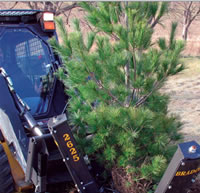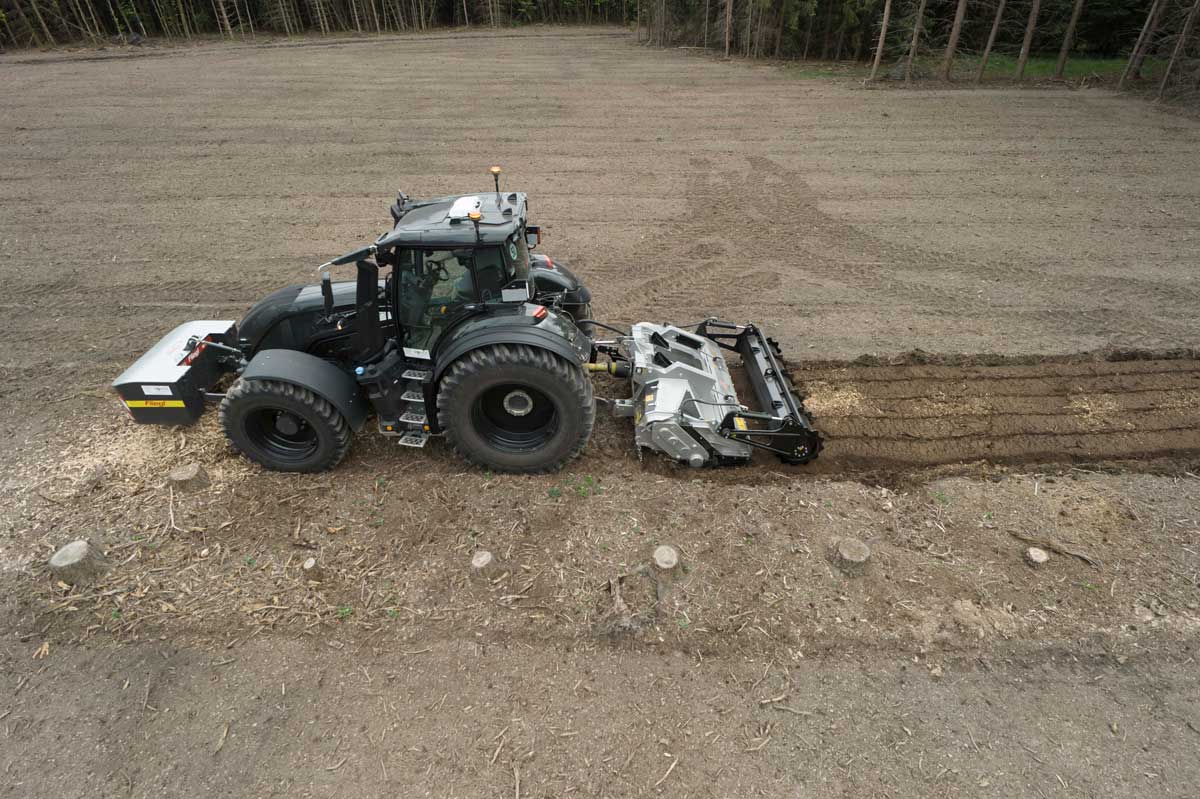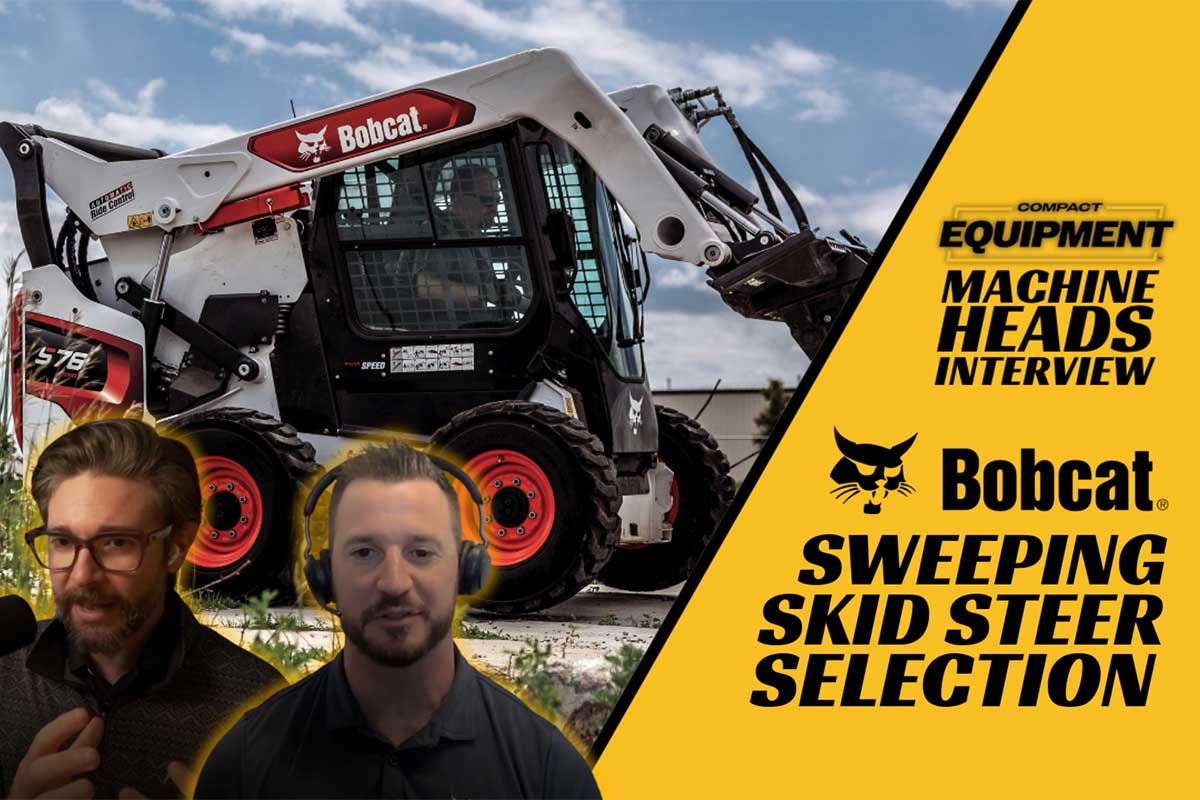Branching Out with a Skid Steer
 A skid steer is always pigeonholed as a piece of construction equipment, but these compact tool carriers are just as useful working on the green space of a landscape site. A skid steer or compact track loader can focus its attachment strengths to help design/build beds and water features, install turf and irrigation and even manage and install trees and shrubs. In fact, hitched to the right tree-oriented attachment, a skid steer can be the ideal marriage of brawn and delicacy needed to transport trees of all types.
A skid steer is always pigeonholed as a piece of construction equipment, but these compact tool carriers are just as useful working on the green space of a landscape site. A skid steer or compact track loader can focus its attachment strengths to help design/build beds and water features, install turf and irrigation and even manage and install trees and shrubs. In fact, hitched to the right tree-oriented attachment, a skid steer can be the ideal marriage of brawn and delicacy needed to transport trees of all types.
From planting and pruning to cutting and removing, there’s a tree-oriented attachment ripe for the task at hand. The U-shaped bucket of a tree spade, offered by many attachment manufacturers such as CEAttachments, FFC Attachments, Bobcat and Ditch Witch, is designed to scoop, dig and transport materials; conversely, it can also transport, dig and plant trees. In the way of planting our perennial partners, the tree spade is king of conifers and deciduous trees alike.
“Tree spades are an economical tool with a number of uses. They can dig holes for new trees and shrubs quickly, and it’s an excellent tool for transporting and placing trees, shrubs and decorative stones. It also works well for digging up trees and stumps,” says Ron Grimstad, product manager for CEAttachments. “Watching a good operator digging with a tree spade is like watching the clerk at the ice cream shop using and ice cream scoop.”
Smooth — that’s the aim of the tree spade’s operation. While some operators might try to duplicate a tree spade’s slick dig, scoop and carry operation with a standard bucket, the job usually turns out sloppy and arduous. However, the tree spade isn’t the only attachment that digs tree planting. The tree transplanter, also known as a hydraulic tree spade, hydraulically drives multiple blades into the ground around the circumference of a tree’s root ball with the goal of removing the tree and its root ball from the ground.
Tree transplanters are considerably larger than tree spades, with three pylons jettisoning from the blade like a droid from “Star Wars.” The rear stabilizers and counter weights, which are typically required for machine stability and to apply the proper down pressure, only add to the skid steer’s futuristic appearance. Offered by the likes of New Holland, CEAttachments and Bradco, a transplanter’s operation is a bit more complex that the tree scooping spade.
“Hydraulic spade [operation] generally requires two people: one operator and one spotter. The operator approaches the tree with the blade gates open. The spade is positioned around the tree base and the gates close around the tree,” explains David Daniels, marketing manager for New Holland Construction. “From a safe distance, the spotter helps the operator get the spade centered and leveled with the tree. Then, the spade is lowered onto its legs and the rear stabilizers are lowered to increase down pressure on the spade.
“Using a cab-mounted remote control, the spade blades are lowered sequentially into the ground to full depth. Once the blades are lowered, the operator raises the rear stabilizers and lifts the spade — ball, tree and all. Normally during the digging process, the spotter has positioned a size- and shape-matched wire basket, lined with burlap, near the site. The operator positions the tree ball in the basket and retracts the blades.”
Operation, however, isn’t the only difference between a spade and transplanter. U-shaped tree spades usually run between $1,000 to $2,000 in cost, while hydraulic transplanters start round $7,000 and climb upward to nearly $19,000. Of course, with the extra cost of a transplanter comes bells and whistles that u-shaped tree spades don’t offer.
“There are two styles of tree spade frames that support the shovels. The outside frame has the frame outside of the shovels; the inside frame has the frame inside the shovels. This new inside design decreases the weight and allows the operator to compress the ball in the basket. It also reduces the overall width to get between trees and shrubs,” says Melani Moorman, marketing services manager for Paladin Brands. “Bradco’s tree spades also have an under-cutting feature that cuts all roots, including tap roots, as the blade is forced into the ground. It also assists the lift and carry of the tree ball in looser soil.”
Whether using a tree spade or transplanter, it’s important to check with utility companies to make sure it’s safe to dig around the tree, avoiding buried utilities. Also remember when transporting a tree to carry the weight low and keep your skid steer’s rated operating capacity in mind. Add the weight of the tree and ball to the spade weight to find your exact load capacities.
Timber!
There are few sights as humbling as a majestic tree growing tall for hundreds of years — unless it’s growing into your neighbor’s second-story bedroom window or the utility company’s power lines.
Tree management is just as important as tree installation. When trimming your woody, perennial plant, a pair of hand shears isn’t going to cut through a 50-year-old limb. For that kind of power, you need to turn to a skid steer’s tree shears. Designed to cut through both hard and soft trees, tree shears come in two different models — standard and high-reach.
Shears are built with two large cylinders and powerful cutting jaws. Equipped with grapples and accumulators, which hold the tree up after cutting, the shears can cut through branches from 8- to 20-in. thick. Although that kind of cutting power puts a grin on an eager landscaper, it’s important that you make sure your skid steer can handle the shears’ load.
“The weight of the tree shear should never exceed the rated capacity of the loader and as a rule of thumb, a maximum shear weight of 75 percent of the skid steer’s rated capacity is a better approach,” says Grimstad. “Generally, shears equipped with grapples and accumulators are considered to be forestry shears and are tools for only the largest of skid steer and track loaders.”
Grimstad laid out a few more operating procedures that should be followed:
- Never operate tree shears in windy conditions
- Never operate tree shears around people
- Make sure the skid steer in use is equipped with an operator enclosure that meets the latest regulations
- Never operate shears on hill sides
- Never position the loader in the direction the tree is landing
- Always cut with the tree as far into the shear jaws as possible
- Always cut perpendicular to the grain of the tree
As with most high-end attachments, heavy-duty tree shears have a price tag to match. The price range starts at about $4,500 for small shears to as much as $14,000 for feature-laden large shears, from manufacturers such as Sheyenne Tooling Mfg. and CEAttachments.
Yet, there are times when the tree has deteriorated to the point where tree shears just won’t cut it. If the tree is old or diseased, it may be host to destructive termites or diseases such as scabs or rusts, which are fungi that harm the tree. In that case, it’s best to remove the tree. Then, you will be left with nothing but a stump.
After tripping over the stump in your backyard several times, you might be in the market for a stump grinder attachment. The stump grinder is mounted on an arm holding a disk full of cutters rotating at high speed, powered by a hydraulic motor. Most are designed to swing left and right over the stump and the depth of cut is controlled by a hydraulic cylinder.
“Most stump cutters feature a cutting wheel with carbide teeth. The unit generally has the wheel mounted on a pivoting arm and is positioned with the cutting wheel over a portion of the stump,” explains Daniels. “Starting at one side of the stump, the cutting wheel is lowered and oscillated back and forth, removing more of the stump with each pass. The depth of cut varies by the size and condition of the stump. The process is repeated until the stump is removed to below ground level.”
When shopping around for a stump cutter attachment, make sure that it has the ability to cut several inches below the grade and the cutter rotation throws chips away from the operator. A heavy, large-diameter cutter wheel will help maintain momentum and power during the cut, while a large left- and right-swing arc minimizes the number of times the skid steer needs to be repositioned. Replaceable cutter teeth on the wheel are also a nice touch. When it’s all said and done, you can expect to drop $5,000 to $9,000 on a stump grinder.
That is a small price to pay to round out your tree care attachment quiver. Planting and pruning is no longer a pain-staking, all-weekend activity. Now, it’s just another reason to take your skid steer for a spin, while providing that luscious green landscape that makes passer-bys take notice.





Comments are closed here.